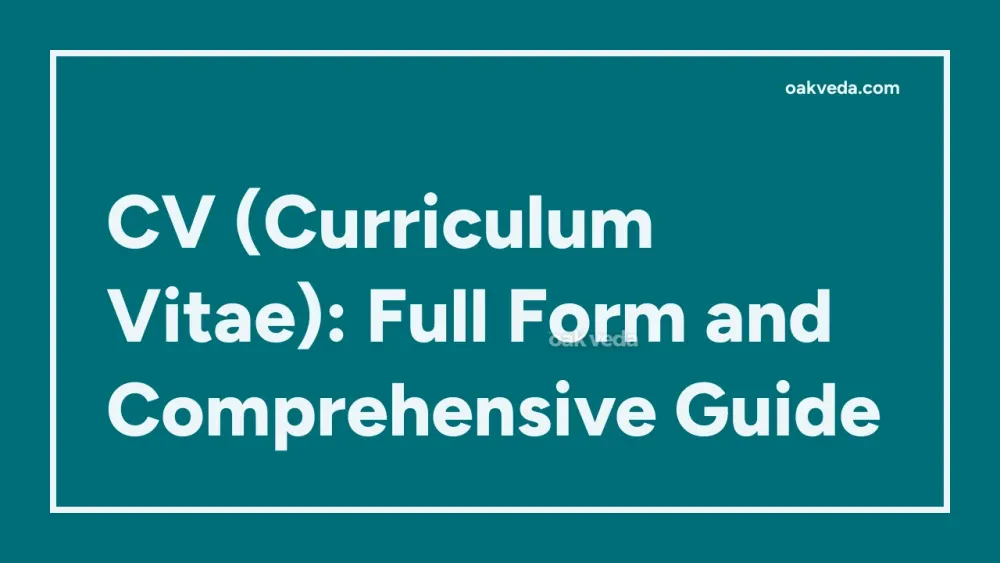
What is the Full Form of CV?
The full form of CV is Curriculum Vitae, which is Latin for "course of life." This comprehensive document provides an overview of an individual's academic and professional journey, showcasing their qualifications, experiences, and achievements.
What is Curriculum Vitae?
A Curriculum Vitae, commonly referred to as a CV, is a detailed document that presents a comprehensive overview of an individual's educational background, work experience, research accomplishments, publications, awards, and other relevant credentials. It serves as a professional biography, offering potential employers or academic institutions a thorough insight into a candidate's qualifications and career trajectory.
Origin and Development of Curriculum Vitae
The concept of the Curriculum Vitae dates back to the 15th century when Leonardo da Vinci wrote a letter to the Duke of Milan, outlining his skills and experiences. However, the modern CV as we know it today began to take shape in the 20th century, evolving alongside changes in the job market and recruitment practices.
How does a Curriculum Vitae work?
A CV works by providing a detailed account of an individual's professional and academic history. It is typically used in the following scenarios:
- Job applications
- Academic positions
- Research grant applications
- Fellowship or internship applications
- Professional networking
Unlike a resume, which is tailored for specific job applications, a CV is a more comprehensive document that remains relatively constant, with updates made as new accomplishments or experiences are acquired.
Types of Curriculum Vitae
While there is no strict classification of CV types, they can be categorized based on their purpose and content:
- Academic CV: Used for academic positions, research roles, and grant applications
- Professional CV: Employed in non-academic job applications, focusing on work experience and skills
- Technical CV: Tailored for positions in IT, engineering, and other technical fields
- Medical CV: Specific to healthcare professionals, highlighting clinical experience and research
- International CV: Adapted to meet the expectations of different countries' job markets
Functions of Curriculum Vitae
The primary functions of a CV include:
- Showcasing academic and professional qualifications
- Highlighting research experience and publications
- Demonstrating career progression and achievements
- Providing a comprehensive overview of skills and expertise
- Serving as a basis for academic or professional evaluation
Applications of Curriculum Vitae
CVs are widely used in various contexts:
- Academic job applications (e.g., professorships, research positions)
- Scientific research grant proposals
- Applications for fellowships or scholarships
- Certain industries where detailed professional history is crucial (e.g., medicine, law)
- International job applications, particularly in Europe and parts of Asia
Features of Curriculum Vitae
A well-crafted CV typically includes the following features:
- Personal Information: Full name, contact details, and professional summary
- Education: Detailed academic history, including degrees, institutions, and graduation dates
- Work Experience: Comprehensive list of professional roles and responsibilities
- Research and Publications: List of research projects, papers, and publications
- Awards and Honors: Academic or professional accolades received
- Skills: Relevant technical, language, and soft skills
- Professional Memberships: Affiliations with relevant organizations or associations
- References: Contact information for professional references (or a statement that references are available upon request)
Benefits of Curriculum Vitae
Using a CV offers several advantages:
- Provides a comprehensive view of an individual's career and qualifications
- Allows for detailed explanation of research, publications, and projects
- Demonstrates academic and professional growth over time
- Offers flexibility in showcasing various achievements and experiences
- Serves as a living document that can be continually updated throughout one's career
Limitations or Challenges of Curriculum Vitae
Despite its benefits, the CV format does have some limitations:
- Length can be a drawback for time-constrained recruiters
- May contain more information than necessary for certain positions
- Requires regular updating to remain current and relevant
- Can be less effective in industries that prefer concise resumes
- May not be suitable for entry-level positions or career changers with limited experience
Future Developments in Curriculum Vitae Technology
As technology continues to evolve, so does the format and presentation of CVs:
- Digital CVs: Interactive online profiles that can be easily updated and shared
- Video CVs: Short video presentations highlighting key qualifications and personality
- AI-powered CV analysis: Tools that help optimize CV content for specific job requirements
- Blockchain-verified credentials: Secure, tamper-proof verification of academic and professional qualifications
- Augmented Reality CVs: Immersive experiences showcasing skills and achievements in a virtual environment
FAQs on CV Full Form
-
What is the difference between a CV and a resume? A CV is typically longer and more detailed than a resume, providing a comprehensive overview of one's academic and professional history. A resume is usually shorter (1-2 pages) and tailored for specific job applications.
-
How long should a CV be? The length of a CV can vary depending on the individual's experience and the purpose. In some countries, like the UK and Ireland, it's typically 2-3 pages, while in other regions, it can be much longer, especially for academic positions.
-
Should I include a photo on my CV? This depends on the country and industry. In most English-speaking countries, photos are not typically included, while in some European and Asian countries, they may be expected.
-
How often should I update my CV? It's best to update your CV regularly, ideally every 6-12 months or whenever you achieve a significant milestone or gain new skills or experiences.
-
Can I use the same CV for different job applications? While the core content of your CV may remain the same, it's advisable to tailor certain sections to align with the specific requirements of each job application.
By understanding the full form and purpose of a CV, you can create a powerful document that effectively showcases your qualifications and advances your career goals. Remember to keep your CV up-to-date and tailored to your target audience for maximum impact.
You may be interested in:

